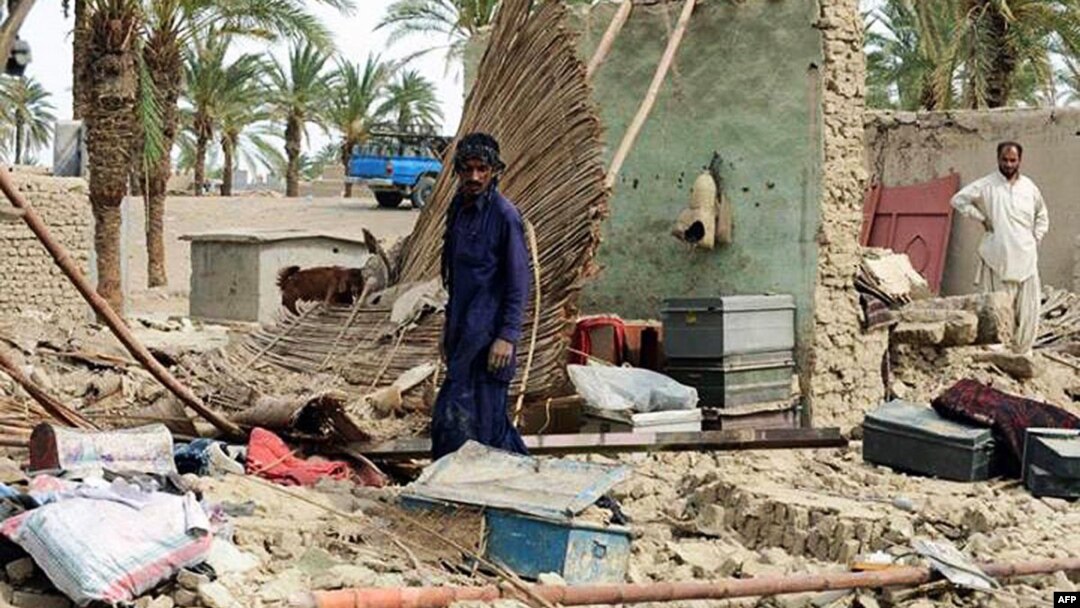Pakistan's military is rushing to provide aid after hundreds were killed and injured in a strong earthquake that struck southwestern Balochistan Province.
A Pakistani government official said on September 26 that the death toll risen to nearly 350 with more than 500 others injured in the 7.7-magnitude quake.
The tremor hit the Awaran district and affected the nearby districts of Kech, Khuzdar, Kharan, Gwadar, Panjgur, and Chaghi on September 24.
The quake destroyed scores of dwellings and knocked out communications networks.
Provincial spokesman Jan Mohammad Bulaidi said that authorities in Balochistan were working with the military to deliver supplies to remote communities in the affected districts.
"Twelve trucks of rations were sent from Quetta yesterday, but since the journey is around 16 or 17 hours long, they will arrive there today," Bulaidi said.
"And now the Provincial Disaster Management Authority has dispatched another seven trucks of provisions to Awaran. We have also set up two medical centers, one at Thal and one at Hub."
Bulaidi said that the quake affected more than 300,000 people. He said scores of injured had been airlifted to hospitals in the country's major cities.
Prone To Earthquakes
The region's remoteness, lack of infrastructure, and sparse population has hampered relief efforts.
Most casualties were reportedly caused by the collapse of mud houses, which are common in impoverished Balochistan.
The quake shook Pakistan's largest city, Karachi, located about 250 kilometers from the epicenter, and was also felt as far away as the Indian capital, New Delhi, some 1,200 kilometers away. The quake was also felt across the Gulf of Oman in Dubai.
Pakistani television news channels showed pictures of a small mountain-like island that popped up after the quake near the port of Gwadar in the Arabian Sea.
Seismologists say the island is likely to be a "mud volcano," which is created by methane gas forcing material upward during a massive earthquake.
The Baluchistan region, which is split between Iran and Pakistan, is prone to earthquakes.
In April, a magnitude-7.8 earthquake which struck across the border in Iran killed at least 35 people in Pakistan's Balochistan Province. A major quake in the region in 1935 killed 60,000 people.
A Pakistani government official said on September 26 that the death toll risen to nearly 350 with more than 500 others injured in the 7.7-magnitude quake.
The tremor hit the Awaran district and affected the nearby districts of Kech, Khuzdar, Kharan, Gwadar, Panjgur, and Chaghi on September 24.
The quake destroyed scores of dwellings and knocked out communications networks.
Provincial spokesman Jan Mohammad Bulaidi said that authorities in Balochistan were working with the military to deliver supplies to remote communities in the affected districts.
"Twelve trucks of rations were sent from Quetta yesterday, but since the journey is around 16 or 17 hours long, they will arrive there today," Bulaidi said.
"And now the Provincial Disaster Management Authority has dispatched another seven trucks of provisions to Awaran. We have also set up two medical centers, one at Thal and one at Hub."
Bulaidi said that the quake affected more than 300,000 people. He said scores of injured had been airlifted to hospitals in the country's major cities.
Prone To Earthquakes
The region's remoteness, lack of infrastructure, and sparse population has hampered relief efforts.
Most casualties were reportedly caused by the collapse of mud houses, which are common in impoverished Balochistan.
The quake shook Pakistan's largest city, Karachi, located about 250 kilometers from the epicenter, and was also felt as far away as the Indian capital, New Delhi, some 1,200 kilometers away. The quake was also felt across the Gulf of Oman in Dubai.
Pakistani television news channels showed pictures of a small mountain-like island that popped up after the quake near the port of Gwadar in the Arabian Sea.
Seismologists say the island is likely to be a "mud volcano," which is created by methane gas forcing material upward during a massive earthquake.
The Baluchistan region, which is split between Iran and Pakistan, is prone to earthquakes.
In April, a magnitude-7.8 earthquake which struck across the border in Iran killed at least 35 people in Pakistan's Balochistan Province. A major quake in the region in 1935 killed 60,000 people.


